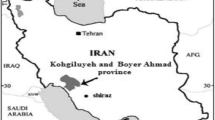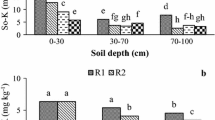Abstract—
Experiments were conducted for thirty representative surface and subsurface soils collected from different physiographic units and moisture regimes in southern Iran to assess factors affecting K pools distribution and potassium release rate, using two organic and inorganic extractants and their association to mineralogy and some physical and chemical properties in calcareous soils. Mineralogical analysis indicated that illite, smectite, chlorite and palygorskite were the main clay minerals in the studied soils. The highest content of illite and smectite was observed in the piedmont plain (P.P) units, whereas that of smectite in Lowland (L.L) unit was higher than in soils of alluvial fans (A.F). It seems that the P.P unit which is in more stable landform position contains larger amounts of all K compounds due to higher clay and illite contents. The exchangeable, non-exchangeable (NEK), structural, and total potassium were found to be significantly and positively correlated to the clay content, cation exchange capacity, and the contents of illite, smectite, and vermiculite minerals, while a negative correlation as observed between the mentioned K forms and the calcium carbonate (CaCO3) content. The cumulative rate of K release to 0.01 M CaCl2 and oxalic acid was examined for a period of 1200 h, ranging within 104–286 and 87–233 mg kg–1 for the surface soil and 98–241 and 82–211 mg kg–1 for the subsurface soil samples, respectively. The percentage of non-exchangeable K released varied greatly between the different units and moisture regimes. Higher values of NEK release were observed for P.P followed by A.F, and L.L units. Considering the obtained values of the highest amount of potassium compounds as well as the release values in the piedmont plain physiographic unit and the xeric moisture regime as well as the Alfisols, the results confirm that in addition to physicochemical and mineralogical properties, physiographic units and soil moisture regimes also play a key role in nature and in spatial distribution of different forms of potassium.




Similar content being viewed by others
REFERENCES
A. Azadi, M. Baghernejad, N. Karimian, and A. Abtahi, “Investigation about potassium status and its relationship with mineralogy and soil properties in Kaftar region Fars Province,” Iran. J. Soil Manage. 2 (3), 59–69 (2014).
A. Azadi, M. Baghernejad, N. Karimian, and A. Abtahi, “Kinetics of nonexchangeable potassium release and relationship with soil properties, mineralogy and soil taxonomy in some calcareous soils of Fars province,” J. Soil Water Sci. 30 (2), 187–199 (2016).
M. R. Balali and M. J. Malakouti, “Study of changes of exchangeable potassium in Iranian agricultural soils,” Soil Water 12 (3), 59–70 (1998).
G. J. Bouyoucos, “Hydrometer method improved for making particle size analyses of soils,” Agron. J. 57 (5), 464–465 (1962). https://doi.org/10.2134/agronj1962.00021962005400050028x
H. D. Chapman, “Cation exchange capacity,” in Methods of Soil Analysis, Part 2: Chemical and Microbiological Properties, Ed. by C. A. Black (American Society of Agronomy, Madison, WI, 1965), Ch. 57, pp. 891–901.
T. R. Fox and N. B. Comerford, “Low-molecular-weight organic acids in selected forest soils of the southeastern USA,” Soil Sci. Soc. Am. J. 54, 1139–1144 (1990). https://doi.org/10.2136/sssaj1990.03615995005400040037x
J. L. Havlin, D. G. Westfall, and S. R. Olsen, “Mathematical models for potassium release kinetics in calcareous soils,” Soil Sci. Soc. Am. J. 49, 371–376 (1985). https://doi.org/10.2136/sssaj1985.03615995004900020020x
P. A. Helmeke and D. L. Sparks, “Lithium, sodium, potassium, rubidium, and cesium,” in Methods of Soil Analysis, Part 3: Chemical Methods (American Society of Agronomy, Madison, WI, 1996), Ch. 19.
A. R. Hosseinpour and M. Kavusi, “Kinetics of release rate of nonexchangeable K along with plant responses in some soils of Gilan province,” Iran. J. Agric. Sci. 35 (2), 347–355 (2004).
M. L. Jackson, Soil Chemical Analysis: Advanced Course (Department of Soils, College of Agriculture, University of Wisconsin, Madison, WI, 1975).
M. Jalali and M. Zarabi, “Kinetics of nonexchangeable–potassium release and plant response in some calcareous soils,” J. Plant Nutr. Soil Sci. 169 (2), 196–204 (2006). https://doi.org/10.1002/jpln.200521772
W. D. Johns, R. E. Grim, and F. Bradley, “Quantitative estimations of clay minerals by diffraction methods,” J. Sediment. Res. 24 (4), 242–251 (1954). https://doi.org/10.1306/D42697B5-2B26-11D7-8648-000102C1865D
J. Kittrick and E. Hope, “A procedure for the particle-size separation of soils for X-ray diffraction analysis,” Soil Sci. 96 (5), 319–325 (1963).
Q. X. Li, Z. Q. Jia, and T. Liu, “Effects of different plantation types on soil properties after vegetation restoration in an alpine sandy land on the Tibetan Plateau, China,” J. Arid Land 9 (2), 200–209 (2017). https://doi.org/10.1007/s40333-017-0006-6
R. H. Loeppert and D. L. Suarez, “Carbonate and gypsum,” in Methods of Soil Analysis, Part 3: Chemical Methods, Ed. by D. L. Sparks, et al. (Soil Science Society of America, American Society of Agronomy, Madison, WI, 1996), pp. 437–474.
H. W. Martin and D. L. Sparks, “Kinetics of nonexchangeable potassium release from two coastal plain soils,” Soil Sci. Soc. Am. J. 47 (5), 883–887 (1983). https://doi.org/10.2136/sssaj1983.03615995004700050008x
H. W. Martin and D. L. Sparks, “on the behavior of non- exchangeable potassium in soils,” Commun. Soil Sci. Plant Anal. 16, 133–162 (1985). https://doi.org/10.1080/00103628509367593
O. Mehra and M. Jackson, “Iron oxide removal from soils and clays by a dithionite–citrate system buffered with sodium bicarbonate,” in Proceedings of the Seventh National Conference on Clays and Clay Minerals (Elsevier, Amsterdam, 1960).
K. Mengel, “Potassium,” in Handbook of Plant Nutrition, Ed. by A. V. Barker and D. J. Pilbeam (CRC Press, Boca Raton, FL, 2006), pp. 91–120.
A. Mousavi, F. Khayamim, H. Khademi, and H. Shariatmadari, “Potassium release kinetics from K-feldspar in comparison with muscovite as influenced by different extractants,” J. Water Soil Sci. 18 (67), 229–240 (2014).
K. Nabiollahy, F. Khormali, K. Bazargan, and S. Ayoubi, “Forms of K as a function of clay mineralogy and soil development,” Clay Miner. 41, 739–749 (2006). https://doi.org/10.1180/0009855064130216
M. Najafi-Ghiri and A. Abtahi, “Potassium fixation in soil size fractions of arid soils,” Soil Water Res. 8 (2), 49–55 (2013). https://doi.org/10.17221/52/2012-SWR
M. Najafi-Ghiri, A. Abtahi, A. Karimian, H. R. Owliaie, and F. Khormali, “Kinetics of non-exchangeable potassium release as a function of clay mineralogy and soil taxonomy in calcareous soils of southern Iran,” Arch. Agron. Soil Sci. 57 (4), 343–363 (2011). https://doi.org/10.1080/03650340903440144
D. W. Nelson and L. E. Sommers, “Total carbon, organic carbon, and organic matter,” in Methods of Soil Analysis, Part 3: Chemical Methods, Ed. by D. L. Sparks, et al. (Soil Science Society of America, American Society of Agronomy, Madison, WI, 1996), pp. 961–1010.
K. Ngwe, I. Kheoruenromne, and A. Suddhiprakarn, “Potassium status and physicochemical and mineralogical properties of lowland Vertisols in a rice-based crop** system under tropical savanna climate,” Kasetsart J. Nat. Sci. 46, 522–537 (2012).
H. R. Owliaie, A. Abtahi, and R. J. Heck, “Pedogenesis and clay mineralogical investigation of soils formed on gypsiferous and calcareous materials, on a transect, southwestern Iran” Geoderma 134, 62–81 (2006). https://doi.org/10.1016/j.geoderma.2005.08.015
A. Raheb and A. Heidari, “Effects of clay mineralogy and physico-chemical properties on potassium availability under soil aquic conditions,” J. Soil Sci. Plant Nutr. 12 (4), 747–761 (2012). https://doi.org/10.4067/S0718-95162012005000029
S. Rezapour, A. Samadi, A. A. Jafarzadeh, and S. Oustan, “Impact of clay mineralogy and landscape on potassium forms in calcareous soils, Urmia region,” J. Agric. Sci. Technol. 12, 495–507 (2010).
Diagnosis and Improvement of Saline and Alkali Soils, Agriculture Handbook no. 60, Ed. by L. A. Richards (US Government Printing Office, Washington, DC, 1954), pp. 1–160.
S. Shakeri, “Effect of soil buffering capacity and clay minerals on the rate coefficient of non-exchangeable potassium release,” Malays. J. Soil Sci. 22, 59–75 (2018).
S. Shakeri and A. Abtahi, “Potassium fixation capacity of some highly calcareous soils as a function of clay minerals and alternately wetting-drying,” Arch. Agron. Soil Sci. 66 (4), 445–457 (2020). https://doi.org/10.1080/03650340.2019.1619176
S. Shakeri and A. Abtahi, “Potassium forms in calcareous soils as affected by clay minerals and soil development in Kohgiluyeh and Boyer-Ahmad Province, Southwest Iran” J. Arid Land 10, 217–232 (2018). https://doi.org/10.1007/s40333-018-0052-8
R. R. Sharma, S. S. Mukhopadhyay, and J. S. Sawhney, “Distribution of potassium fractions in relation to landform in a Himalayan catena,” Arch. Agron. Soil Sci. 52 (4), 469–476 (2006). https://doi.org/10.1080/03650340600743717
A. K. Sinha and S. Biswas, “Distribution of different forms of potassium in surface and subsurface horizons of some well-established soils of West Bengal under the order inceptisols,” J. Interacad. 7 (3), 286–291 (2003).
Soil Survey Staff, Keys to Soil Taxonomy, 2nd ed. (Natural Resources Conservation Service, Washington, DC, 2014), pp. 43–316.
D. L. Sparks, “Bioavailability of soil potassium,” in Handbook of Soil Science (CRC Press, Boca Raton, FL, 2000), pp. 38–52.
C. S. Rao, A. Swarup, A. Rao, and V. Gopal, “Kinetics of nonexchangeable potassium release from a T-ropaquept as influenced by long-term crop**, fertilization, and manuring,” Austr. J. Soil Res. 33, 317–328 (1999). https://doi.org/10.1071/S98049
C. Srinivasarao, T. R. Rupa, A. Subba Rao, G. Ramesh, and S. K. Bansal, “Release kinetics of nonexchangeable potassium by different extractants from soils of varying mineralogy and depth,” Commun. Soil Sci. Plant Anal. 37, 473–491 (2006). https://doi.org/10.1080/00103620500449351
F. J. Stevenson, Humus Chemistry (Wiley, New York, 1982).
H. Y. Wang, Q. H. Shen, J. M. Zhou, J. Wang, C. W. Du, and X. Q. Chen, “Plants use alternative strategies to utilize nonexchangeable potassium in minerals,” Plant Soil 343 (1–2), 209–220 (2011). https://doi.org/10.1016/S1002-0160(10)60026-4
M. A. Wani, “Oxalic acid effect on potassium release from typical rice soils of Kashmir,” Commun. Soil Sci. Plant Anal. 43 (8), 1136–1148 (2012). https://doi.org/10.1080/00103624.2012.662562
Funding
This research did not receive any specific funding.
Author information
Authors and Affiliations
Corresponding author
Ethics declarations
The authors declare that they have no conflict of interest.
Rights and permissions
About this article
Cite this article
Abolfazl Azadia, Sirous Shakeri Potassium Pools Distribution in Some Calcareous Soils as Affected by Climatic Conditions, Physiographic Units, and Some Physicochemical Properties in Fars Province, Southern Iran. Eurasian Soil Sc. 54, 702–715 (2021). https://doi.org/10.1134/S1064229321050021
Received:
Revised:
Accepted:
Published:
Issue Date:
DOI: https://doi.org/10.1134/S1064229321050021




